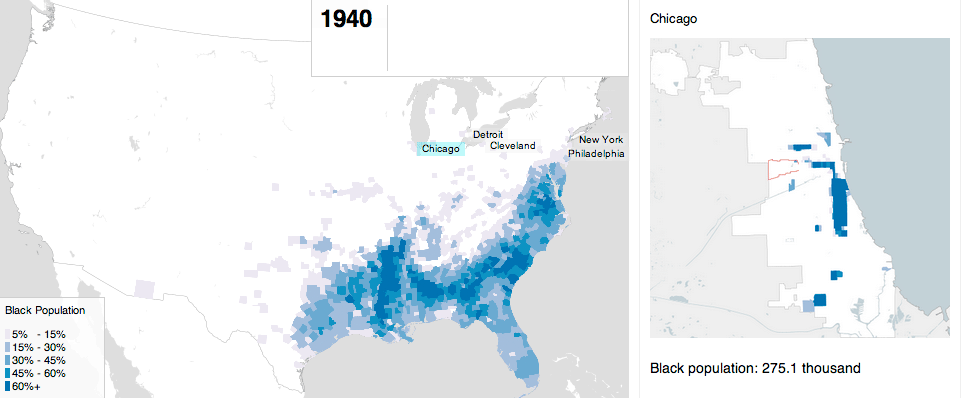 |
| Black Population Change, North Lawndale outlined in red. (Source: ProPublica, Housing Segregation: the Great Migration and Beyond by Jeff Larson and Nikole Hannah-Jones) |
African Americans left the South in large numbers from 1910 to 1970. They were leaving behind the white oppression of segregation, the Jim Crow laws, and lack of opportunity in the South, in search of industrial jobs, better schools, and the right to vote in the North. Many found work in sectors such as railroad expansion, meatpacking, the stockyards, and the steel, auto, and shipbuilding industries. The first major phase of migration occurred during WWI, which effectively stopped immigration from Eastern Europe. Increased manufacturing during the wartime economy opened up jobs for many African Americans in northern cities. WWII similarly stimulated an increase in the northern migration of African Americans. 2
 |
| (Source: University of Illinois at Chicago, The University Library, Special Collections Department, Chicago Urban League Records [CUL neg. 53]) |
Upon arrival to northern cities, African Americans would be confined to live in certain areas because of racial segregation and racial restrictive covenants. In Chicago, this area was on the south side and called the "Black Belt", which today is the Bronzeville neighborhood. In the "Black Metropolis" of Chicago, the African American community was able to develop their own infrastructure of newspapers, businesses, jazz clubs, churches, and political organizations. Between 1940 and 1960, the African American population of Chicago increased from 278,000 to 813,000. The Bronzeville neighborhood became so overcrowded that African Americans searched for housing in other parts of the city, particularly on the west side and in North Lawndale.3
In North Lawndale and elsewhere, realtors induced panic in white homeowners who feared the arrival of African Americans to their neighborhoods. Thus, white homeowners sold their homes to realtors for less than the actual value of the home. Then by exploiting the desperate need for adequate housing within the African American community, the realtor would sell the property to black families on contract at well-above market value. This was a system of blockbusting, panic-peddling, and contract selling, when a contract buyer would be evicted for missing a single payment on their property without the right to recover any of the payment they had already put into that home.
1 "Great Migration(African American)", Cultural Changes. Wikipedia, Online.
2 Encyclopedia of Chicago. "Great Migration". Online.
3 "Great Migration(African American)". Wikipedia, Online.
